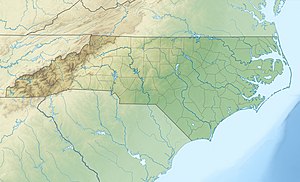Champ Creek
Appearance
| Champ Creek Tributary to Ararat River | |
|---|---|
| Location | |
| Country | United States |
| State | North Carolina |
| County | Surry |
| Physical characteristics | |
| Source | Faulkner Creek divide |
| • location | pond about 2 miles east of Mount Airy, North Carolina |
| • coordinates | 36°31′27″N 080°35′04″W / 36.52417°N 80.58444°W[1] |
| • elevation | 1,270 ft (390 m)[2] |
| Mouth | Ararat River |
• location | about 0.5 miles northeast of Mount Airy, North Carolina |
• coordinates | 36°31′09″N 080°35′06″W / 36.51917°N 80.58500°W[1] |
• elevation | 1,035 ft (315 m)[2] |
| Length | 3.37 mi (5.42 km)[3] |
| Basin size | 2.95 square miles (7.6 km2)[4] |
| Discharge | |
| • location | Ararat River |
| • average | 4.51 cu ft/s (0.128 m3/s) at mouth with Ararat River[4] |
| Basin features | |
| Progression | Ararat River → Yadkin River → Pee Dee River → Winyah Bay → Atlantic Ocean |
| River system | Yadkin River |
| Tributaries | |
| • left | unnamed tributaries |
| • right | unnamed tributaries |
| Bridges | Stardust Trail, Duck Hollow Trail, Arrington Lane, Graystone Road, McBride Road, State Road |
Champ Creek is a 3.37 mi (5.42 km) long 1st order tributary to the Ararat River in Surry County, North Carolina. This stream is the only one of its name in the United States.
Course
[edit]Champ Creek rises in a pond on the Faulkner Creek divide about 2 miles east of Mount Airy, North Carolina. Champ Creek then flows southwest to join the Ararat River about 0.5 miles northeast of Mount Airy.[2]
Watershed
[edit]Champ Creek drains 2.95 square miles (7.6 km2) of area, receives about 47.8 in/year of precipitation, has a wetness index of 337.25, and is about 51% forested.[4]
See also
[edit]References
[edit]- ^ a b "GNIS Detail - Champ Creek". geonames.usgs.gov. US Geological Survey. Retrieved 19 September 2020.
- ^ a b c "Champ Creek Topo Map in Surry". TopoZone. Locality, LLC. Retrieved 19 September 2020.
- ^ "ArcGIS Web Application". epa.maps.arcgis.com. US EPA. Retrieved 19 September 2020.
- ^ a b c "Champ Creek Watershed Report". US EPA Geoviewer. US EPA. Retrieved 19 September 2020.


